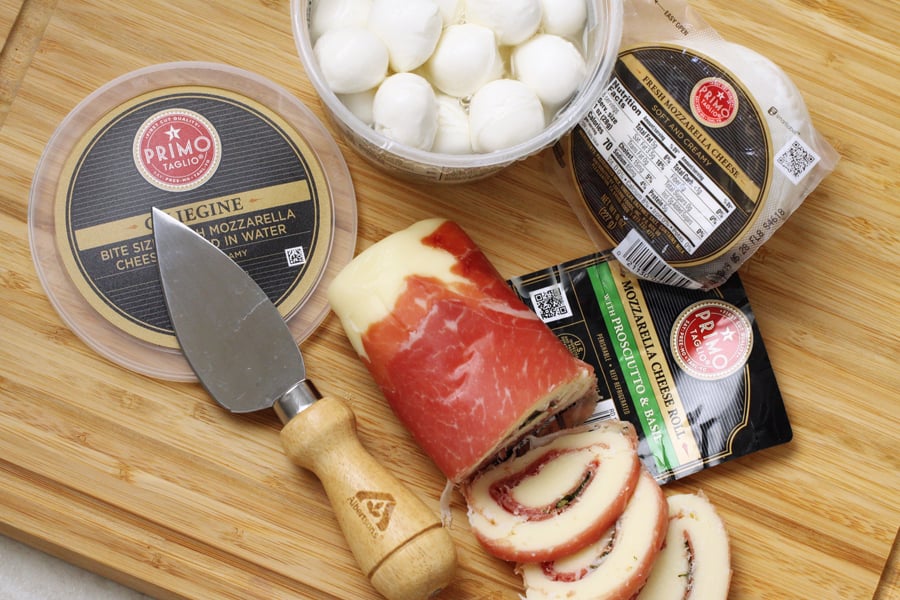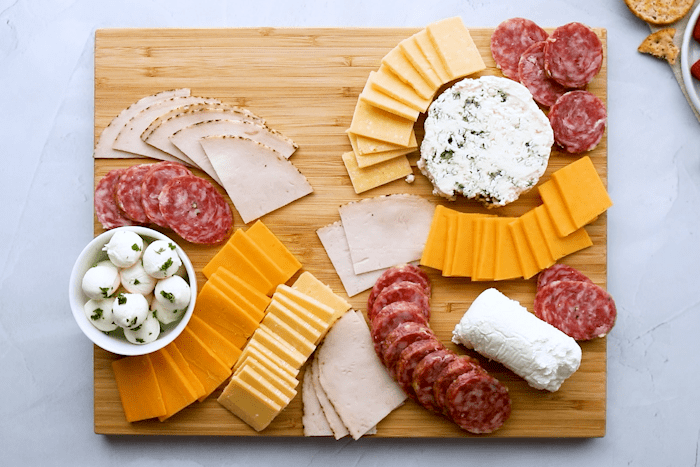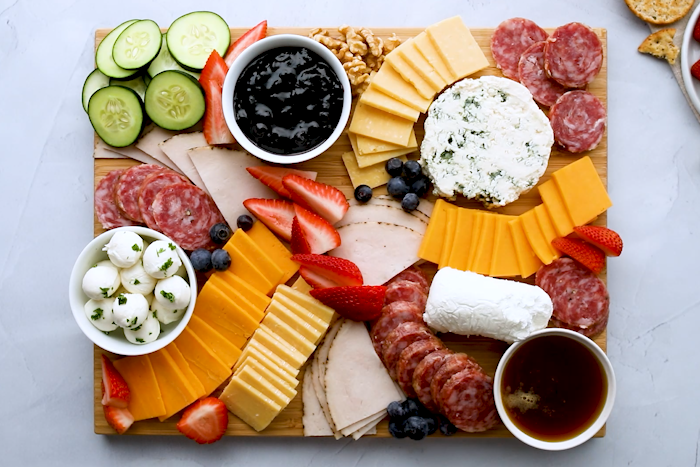This post may contain affiliate links. See our disclosure policy.
Charcuterie boards are so easy to make and always make for an impressive spread. Bring one of these and you will easily be the star of your next party!

What is a Charcuterie Board?
“Charcuterie” roughly translated from French means “delicatessen”. It is basically a serving of a variety of meats. The latest trend is adding cheese, fruit, crackers, and a variety of all sorts of little finger foods onto a large tray along with the meat. I love charcuterie boards because the possibilities are ENDLESS. I love trying all the different combinations of meats, cheeses, and spreads.
Charcuterie Pronunciation
I have heard the word “charcuterie” pronounced all sorts of ways, however, the correct pronunciation is “shar-koo-tuh-ree”.
The 3 3 3 3 Rule
The “3-3-3-3 rule” is a guideline often used for creating a balanced and visually appealing charcuterie board. It helps you organize the different components of the board to ensure variety and a pleasing presentation. The rule suggests including:
- 3 Types of Meat: Include three types of cured meats or charcuterie, such as prosciutto, salami, and chorizo. This adds depth to the flavors and provides options for different preferences.
- 3 Types of Cheese: Select three different types of cheeses to offer a variety of flavors, textures, and milk sources. For example, you might choose a soft cheese (like brie or camembert), a semi-hard cheese (like cheddar or gouda), and a firm cheese (like parmesan or manchego).
- 3 Types of Crackers or Bread: Offer three different types of crackers, breadsticks, or slices of baguette to provide a base for your cheeses and meats. Consider options like plain, whole grain, and something with a unique flavor or texture.
- 3 Types of Accompaniments: Include three types of accompaniments to add variety and balance. These can include items like olives, nuts, dried fruits, fresh fruits, pickles, spreads, honey, or jams.
Following this rule helps ensure that your charcuterie board has a diverse selection of flavors, textures, and colors, making it visually appealing and enjoyable for your guests. Keep in mind that while the “3-3-3-3 rule” is a helpful guideline, you can always adjust the quantities and types of items based on your and your guests preferences and for the overall look of your board.

Charcuterie Board Meats
A true charcuterie board is served with a variety of cold cuts and meats. You can literally use anything that you think your guests will like. Go to your local deli and hand-pick the meats. They can also slice the meats to your desired thickness, which adds more interest your your charcuterie board. Here are some meat ideas to try:
- Ham
- Pepperoni
- Prosciutto
- Roast beef
- Turkey
- Bacon (Try it with candied bacon– so good!)
- Prosciutto
- Salami
- Chorizo
- Soppressata
- Capicola
- Mortadella
- Coppa
- Pancetta
- Sausage
- Bresaola
- Genoa Salami
- Lomo Ibérico
What Cheeses To Use on a Charcuterie Board
For our platter we used all Primo Taglio cheese from the deli area at Albertsons. There were so many to choose from it was so hard to decide! When making a charcuterie board, remember to choose the best cheeses with a variety of firmness and textures. It is a safe bet to use one cheese from each of these categories:

Soft Cheese:
- Fresh Mozzarella (Marinated Mozzarella balls work great)
- Brie
- Camembert
- Triple Cream
- Goat Cheese (Chèvre)
- Cream Cheese with Herbs
- Burrata
- Roquefort
Semi-Hard Cheeses:
- Swiss
- Cheddar
- Gouda
- Gruyere
- Havarti
- Provolone
- Comté
- Emmental
- Jarlsberg
- Havarti
- Fontina
- Edam
Hard Cheese:
- Parmigiano-Reggiano
- Pecorino Romano
- Manchego
- Asiago
- Grana Padano
- Aged Cheddar or Aged Gruyere
Blue Cheese:
- Roquefort
- Gorgonzola
- Stilton
- Danish Blue
- Cambozola
- Maytag Blue
- Fourme d’Ambert
Feel free to mix and match cheeses from these categories to create a diverse and flavorful charcuterie board.

Crackers, Breads, and Starches
We used some whole-grain crackers and gluten-free crackers for our charcuterie board. It is always a good idea to make sure you can have some kind of GF cracker to accommodate those with gluten allergies. You can also use sliced French baguettes or other bread pieces. Here is a list of breads, crackers, and more carbs you can try:
- Crackers: Choose a mix of plain and flavored crackers such as water crackers, whole wheat crackers, sesame crackers, or herb-infused crackers.
- Bread: Slices of baguette, artisan bread, or breadsticks can be great for adding texture and substance.
- Crostini: Thin slices of toasted baguette that provide a sturdy base for toppings.
- Pita Chips: Sturdy pita chips are great for dipping into spreads and cheeses.
- Grilled Bread: Slices of grilled bread brushed with olive oil can add a nice smoky flavor.
- Tortilla Chips: For a slightly unconventional twist, you can include tortilla chips as a base for some spreads or dips.
- Pretzels: Mini pretzels or pretzel crisps can provide a salty and crunchy element.
- Rice Crackers: Thin and crunchy rice crackers that come in various flavors.
- Flatbreads: Thin, crispy flatbreads or naan bread that can be broken into smaller pieces.
- Bagel Chips: Mini bagel slices toasted until crispy.
- Sourdough Rounds: Slices of sourdough bread that have been toasted or baked until crisp.
- Focaccia: Soft and flavorful focaccia bread that can be torn into smaller pieces.
- Popcorn: A unique addition that can add a fun and unexpected touch.
- Naan Bread: Soft and chewy naan bread cut into smaller pieces.
- Rice Cakes: Light and airy rice cakes that can be topped with various spreads.
- Sesame Sticks or Hard Breadsticks: Crunchy sticks add a fun dimension to the board. Put them in a jar so they stick up straight. This way they won’t take up a lot of room on your board.
- Melba Toast: Thin, crisp toasts that are often served with spreads.

Fresh and Dried Fruit
For our charcuterie board we used fresh strawberries, blueberries, blackberries, and raspberries. For the dried fruit we used mango, apricot, golden raisins, and pineapple. Here are some more suggestions:
- grapes
- figs
- huckleberries
- kiwi
- orange slices
- berries – strawberries, blackberries, raspberries
- pineapple
- apricots
- cherries
- peaches
- apples
- pears
- cranberries
- any dried fruit or stone fruit
Charcuterie Board Vegetables
We actually didn’t use any vegetables on our board, mostly because they take up a lot of room. It was easier to serve the vegetables on a separate tray. However, if you have a giant board, you can add vegetables right along with everything else! Try some of these:
- cucumber
- pickles (our Virginia Chunk Sweet Pickles are always a hit)
- carrots
- broccoli or cauliflower
- bell peppers – green peppers, red peppers, or yellow peppers
- celery
- snap peas
- cherry tomatoes or grape tomatoes (a fruit but best served with the vegetables)
- green olives, black olives, or kalamata olives (again, a fruit but goes best with the veggies)
Nuts and Seeds
For the nuts and seeds we used almonds, walnuts, and roasted pepita seeds (a variety of pumpkin seed). You can use any variety of nuts and seeds you would like. Go to the bulk section of your store and try finding some with different seasonings and glazes!
- almonds
- walnuts
- pepita seeds
- pumpkin seeds
- sunflower seeds
- pistachios
- pecans
- hazelnuts
- macadamia nuts
- peanuts
- cashews
The Best Preserves and Spreads
Try using a variety of preserves and spreads to serve along with your charcuterie board. We used fig butter and honey for our platter. Here are some other ideas:

Spreads:
- Fig jam or spread
- bacon jam
- Olive tapenade
- Sun-dried tomato spread
- Roasted red pepper hummus
- Pesto (basil, sun-dried tomato, or other variations)
- Boursin or herbed cream cheese
- Honey mustard
- Garlic aioli or mayonnaise
- Whipped goat cheese or feta spread
- Fruit chutney
- Flavored honey
- Chocolate or Hazelnut Spread
- Marshmallow fluff
Preserves:
- Raspberry jam
- Apricot preserves
- Blackberry jam
- Orange marmalade
- Strawberry preserves
- Blueberry compote
- Cranberry sauce
- Red onion jam
- jalapeno pepper jelly
- Fig preserves
How To Arrange A Charcuterie Board
Try arranging your plate in a way that there is a variety of colors, textures, and sizes all over the board. Use little serving cups if you need to keep things from going all over the place, that is totally fine. There really is no wrong way to make a charcuterie board! Here are some basic tips for arranging your board:

- Start with the Board: Choose a large wooden board, slate, or platter as your base. The size of the board will depend on the amount of food you’re serving.
- Balance and Variety: Aim for a balanced mix of colors, textures, flavors, and shapes. Vary the sizes of the food items to create visual interest.
- Placement of Cheeses and Meats: Place the cheeses and meats first, scattering them around the board to create focal points. Fold or roll the cured meats for an elegant touch.
- Grouping and Clusters: Create clusters of similar items, like a group of cheeses, a collection of fruits, and a cluster of nuts. This helps with organization and makes it easy for guests to choose what they want.
- Crackers and Breads: Arrange crackers, breadsticks, and slices of baguette near the cheeses and meats. You can also prop some up vertically for added height. If you find that you are running out of room on your board, you can always serve these on the side.
- Fruits and Vegetables: Fill in spaces with fresh and dried fruits, as well as vegetables like cherry tomatoes, cucumber slices, and olives. Distribute them evenly for a pop of color.
- Nuts and Spreads: Scatter nuts like almonds and walnuts in open areas. Place small bowls of spreads and dips strategically around the board.
- Garnishes: Use fresh herbs, edible flowers, or small decorative elements to add a finishing touch and elevate the visual appeal.
- Utensils and Serving Tools: Include small cheese knives, toothpicks, and spreaders to make it easy for guests to serve themselves.
- Spacing and Flow: Ensure there’s enough space between items to make it easy to pick up and avoid overcrowding. Consider the flow of the arrangement from one side of the board to the other.
- Fill Empty Spaces: If you have empty spaces, you can add more food or use small decorative items like bowls of olives or containers of nuts.
- Personal Touch: Add labels or small cards describing the cheeses, meats, and other items for your guests’ convenience.
- Seasonal Touch: Add fruits and vegetables that are fresh and in season.
- Final Details: Step back and take a look at your board. Make any final adjustments to ensure everything looks visually appealing and balanced.

Tips For Making A Charcuterie Board
- Try to prepare your charcuterie board fresh, within an hour of serving
- Use little serving spoons and cheese knives to make serving easier
- Keep any extra ingredients you have close by so you can refill the board as needed
- Buy seeds, nuts, and dried fruits in the bulk section of your grocery store.

Frequently Asked Questions
3 Types of Meat: Include three types of cured meats or charcuterie, such as prosciutto, salami, and chorizo. This adds depth to the flavors and provides options for different preferences.
3 Types of Cheese: Select three different types of cheeses to offer a variety of flavors, textures, and milk sources. For example, you might choose a soft cheese (like brie or camembert), a semi-hard cheese (like cheddar or gouda), and a firm cheese (like parmesan or manchego).
3 Types of Crackers or Bread: Offer three different types of crackers, breadsticks, or slices of baguette to provide a base for your cheeses and meats. Consider options like plain, whole grain, and something with a unique flavor or texture.
3 Types of Accompaniments: Include three types of accompaniments to add variety and balance. These can include items like olives, nuts, dried fruits, fresh fruits, pickles, spreads, honey, or jams.
Avoid fruits and vegetables that will go brown.
Check for allergens with the group you are serving.
Avoid overly spicy foods or overpowering scents.
Lay 4 slices of cheese or salami overlapping each other by about 1 inch. Fold the row of slices in half, making one edge a straight line where all 4 slices are folded. Starting at one end, slowly roll up, creating a tight flower-like shape.
More Charcuterie Board Ideas
Since the idea of charcuterie boards have become so popular, people have taken the idea and run with it! If you are looking for more of a meat and cheese tray for sandwiches, try our Deli Style Meat and Cheese Board. Dessert boards are arranged in the same smorgasbord style but with all sweets and treats instead of meats and cheeses. They are so fun and you can tailor them to any theme.
Want MORE? Check out ALL of our Charcuterie Board Ideas!
How to Make a Charcuterie Board

How to Make a Charcuterie Board
Video
Ingredients
- ½ pound Primo Taglio cheese (2-3 varieites, cut into 1 1/2"squares)
- 4 ounces fresh mozzarella balls (marinated)
- 4 ounces soft cheese (2-3 varieties, see suggestions above)
- 4 ounces semi-firm cheeses (or firm, 2-3 varieties, see suggestions above)
- 1/2 pound Primo Taglio cold cuts (2-3 varieties, sliced into 1 1/2" squares or circles)
- 4 ounces hard salami
- 1/2 cup fruit preserves (fig, strawberry, raspberry, etc…)
- 1/3 cup honey
- 1 pound fruit (2-3 varieties of dried and fresh, see notes above)
- 1 pound vegetables (2-3 varieties, see notes above)
- 1 pound nuts & seeds (3-4 varieties, see notes above for suggestions)
- 1 pound crackers
Instructions
- On large wooden cutting board (I used one that is about 15×20") or plate arrange cheeses randomly across the board. Place mozzarella balls in a small dish to keep them from rolling around.

- Next, cut meats into small servings and place on the board. Try to use a variety of sizes and textures randomly over the board.

- Place fruit preserves and honey in little bowls or serving cups and place on the board.

- Wash all fresh fruits and vegetables and cut into small serving sizes. Place fruit, dried fruit, vegetables, and nuts randomly across the board, again trying to use a variety of textures on different parts of the board.

- Fill in all the empty spaces you can. If you have a lot of empty spaces, fill them with crackers or serve the crackers on the side.





Excelent!!!
This was so helpful making my first board! And so yummy!
Can’t wait to use this for the holidays! Great collection of tips!
Creating charcuterie for a 1 to 1.5 hour wedding cocktail hour to be followed by a buffet meal. Your recipe serves 16…are the servings appetizer or main meal servings? How would I upscale your recipe for 100 guests? Any insights are appreciated.
The servings are for an appetizer, not a main dish. I would plan on 1-2 ounces of meat per person and 1-2 ounces of cheese. I would also plan on 3-4 ounces of bread/crackers/nuts per person. I hope this helps!
This is so helpful! It makes putting together a meat and cheese board so simple. Love that you have written out exactly what to include. Will definitely use this as a guide for my parties. Thanks so much for sharing 🙂
I absolutely love doing these for a party. They are so elegant. Love the version you have!
Who doesn’t love a good charcuterie board! You can customize in any way for everyones liking! I love this
The perfect guide to a Charcuterie Board! Can’t wait to try it out 🙂
I LOVE a good charcuterie board. the options are endless, plus you can get salty, sweet, creamy, crunchy. like every flavor & texture combination
I added mini homemade breadsticks to mine, or you can use pickle spears placed in a clear cup.